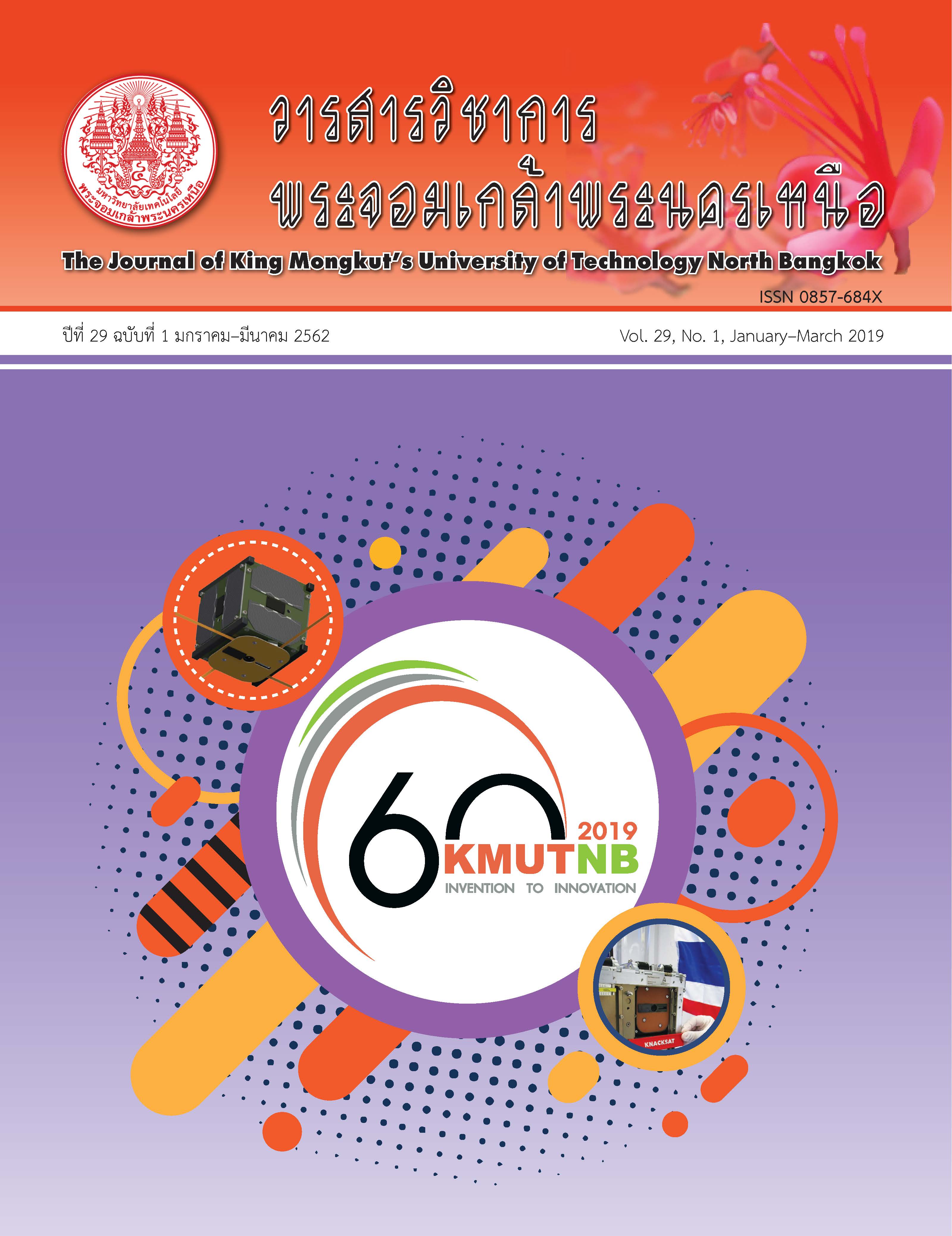การศึกษาการแพร่กระจายความเข้มข้นของสารพิษที่ได้รับอิทธิพลจากความเร็วการไหลของน้ำในแม่น้ำและคลองที่ไหลมาบรรจบกัน
Main Article Content
บทคัดย่อ
ปัญหามลพิษเป็นปัญหาที่สำคัญ และส่งผลต่อการดำรงชีวิตของมนุษย์ ไม่ว่าจะเป็นมลพิษทางอากาศ หรือมลพิษทางน้ำในกรณีของมลพิษทางน้ำ ถ้าหากน้ำไม่สะอาด อาจส่งผลต่อน้ำสำหรับการบริโภค การอยู่อาศัยของสัตว์น้ำ และการประมง นอกจากนี้ยังส่งผลทางอ้อมโดยส่งกลิ่นเหม็นรบกวนได้ ในงานวิจัยนี้ศึกษาการแพร่กระจายความเข้มข้นของสารพิษที่ถูกปล่อยลงสู่คลองและไหลต่อไปยังแม่น้ำ ซึ่งถูกจำลองมาจากลักษณะภูมิประเทศจริงในประเทศไทย การวิเคราะห์และคำนวณจากสมการความต่อเนื่อง สมการโมเมนตัม และสมการการแพร่กระจายความเข้มข้นของสารด้วยโปรแกรมคอมพิวเตอร์ที่อยู่บนพื้นฐานของระเบียบวิธีไฟไนต์เอลิเมนต์ (Finite Element Method; FEM) ในงานวิจัยศึกษาถึงผลกระทบของความเร็วการไหลต่อการแพร่กระจายความเข้มข้นของสารพิษ ที่ความเร็วการไหลของน้ำในคลองที่มีค่า Reynold Number 8.3 × 104, 1.2 × 105 และ 1.7 × 105 และความเร็วการไหลของน้ำในแม่น้ำที่มีค่า Reynold Number 2.15 × 105, 4.3 × 105 และ 8.6 × 105จากผลการวิจัยพบว่าโดยทั่วไปแล้วความเร็วการไหลในแม่น้ำสูงจะทำให้ความเร็วการไหลในคลองสูงขึ้น และความเร็วการไหลในคลองสูงจะทำให้ความเร็วการไหลในแม่น้ำสูงขึ้นเช่นเดียวกัน เพราะฉะนั้นแล้วในกรณีที่มีความเร็วการไหลสูงจะทำให้ความเข้มข้นเฉลี่ยของสารพิษเพิ่มขึ้นอย่างรวดเร็วและมีค่าสูง แต่สามารถลดความเข้มข้นเฉลี่ยได้รวดเร็วเช่นเดียวกัน ยกเว้นบางกรณีที่ความเร็วการไหลในคลองและแม่น้ำต่ำมากทำให้ค่าความเข้มข้นเฉลี่ยสูงขึ้น และบางค่าความเร็วทำให้เกิดการปะทะกันของน้ำที่จุดบรรจบกันของคลองและแม่น้ำส่งผลให้สารพิษสะสมบริเวณนั้นเป็นปริมาณมากและความเข้มข้นเฉลี่ยเพิ่มสูงขึ้นผลจากงานวิจัยนี้สามารถนำไปพัฒนาและประยุกต์ใช้กับแบบจำลองอื่นๆ หรือปัญหาที่คล้ายคลึงกันได้ เพื่อประโยชน์ในการจัดการปัญหาด้านมลพิษ
Article Details
บทความที่ลงตีพิมพ์เป็นข้อคิดเห็นของผู้เขียนเท่านั้น
ผู้เขียนจะต้องเป็นผู้รับผิดชอบต่อผลทางกฎหมายใดๆ ที่อาจเกิดขึ้นจากบทความนั้น
เอกสารอ้างอิง
[2] Ministry of Natural Resources and Environment. (2016, March). PCD: Water Quality Stansards. Pollution Control Department, Thailand [Online]. Available: http://www.pcd.go.th/info_serv/reg_std_water04.html.
[3] D. Ambrosi, S. Corti, V. Pennati, and F. Saleri, “Numerical simulation of unsteady flow at Po river delta,” Journal of Hydraulic Engineering, vol. 122, no. 12, pp. 735–743, 1996.
[4] K. F. Bradbrook, S. N. Lane, and K. S. Richards, “Numerical simulation of three-dimensional, time-averaged flow structure at river channel confluences,” Water resources research, vol. 36, no. 9, pp. 2731–2746, 2000.
[5] J.H. Amorim, V. Rodrigues, R. Tavares, J. Valente, and C. Borrego, “CFD modelling of the aerodynamic effect of trees on urban air pollution dispersion,” Science of the Total Environment, vol. 461–462, pp. 541–551, 2013.
[6] S. Holmberg and Y. Li, “Modelling of the indoor environment–particle dispersion and deposition,” Indoor Air, vol. 8, no. 2, pp. 113–122, 1998.
[7] V. M. Cristea, E. D. Bâgiu, and P. Ş. Agachi, “Simulation and control of pollutant propagation in Someş river using COMSOL multiphysics,” Computer Aided Chemical Engineering, vol. 28, pp. 985–990, 2010.
[8] V. M. Cristea, “Counteracting the accidental pollutant propagation in a section of the river Someş by automatic control,” Journal of Environmental Management, vol. 28, pp. 828–836, 2013.
[9] C. Gualtieri, “RANS-based simulation of transverse turbulent mixing in a 2D geometry,” Environmental Fluid Mechanics, vol. 10, no. 1–2, pp. 137–156, 2010.
[10] J. G. Duan, “Simulation of flow and mass dispersion in meandering channels,” Journal of Hydraulic Engineering, vol. 130, no. 10, pp. 964–976, 2004.
[11] V. Petrescu and O. Sumbasacu, “Comparison between numerical simulation and measurements of the pollutant dispersion in a river, Case study,” UPB Sci. Bull., vol. 72, no. 3, pp. 157–164, 2010.
[12] N. Tantemsapya, “Modeling approach to water quality management in the lower Pong river, Thailand,” Asia-Pacific Journal of Science and Technology, vol. 13, no. 10, pp. 1199–1206, 2017.
[13] E. S. Saltzman, D. B. King, K. Holmen, and C. Leck, “Experimental determination of the diffusion coefficient of dimethylsulfide in water,” Journal of Geophysical Research: Oceans, vol. 98, no. C9, pp. 16481–16486, 1993.

